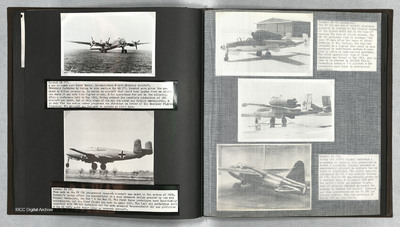Heinkel He 277 and He 280
Title
Heinkel He 277 and He 280
Description
Photo 1 is a a front/ starboard view of a He 277 on the ground. It was designed as a high altitude bomber and reconnaissance aircraft.
Photo 2 is a side view of a He 280 in low level flight. It was powered by two jets.
Photo 2 is a side view of a He 280 in low level flight. It was powered by two jets.
Coverage
Language
Type
Format
Two b/w photographs on an album page
Publisher
Rights
This content is available under a CC BY-NC 4.0 International license (Creative Commons Attribution-NonCommercial 4.0). It has been published ‘as is’ and may contain inaccuracies or culturally inappropriate references that do not necessarily reflect the official policy or position of the University of Lincoln or the International Bomber Command Centre. For more information, visit https://creativecommons.org/licenses/by-nc/4.0/ and https://ibccdigitalarchive.lincoln.ac.uk/omeka/legal.
Identifier
PThomasAF20070025
Transcription
[Photograph]
Heinkel HE 277.
A six or seven seat Heavy Bomber, Reconnaisance [sic] & Anti-Shipping Aircraft.
Expressly forbidden by Goring to even mention the HE 277, Heinkel were given the go-ahead by Hitler personally. He wanted an aircraft that could bomb London from an altitude where it was safe from fighter attack, & for operations far out in the Atlantic. After a conference held in May 1944, Goring ordered the immediate production of 200 aircraft per month, but at this stage of the war the order was totally unrealistic, & in July 1944 the entire bomber programme was abandoned in favour of the Emergeny [sic] Fighter Programme. The aircraft was designed to operate at 49210 feet.
[Photograph]
Heinkel HE 280.
When work on the HE 178 jet-powered research aircraft was ended in the autumn of 1939, Heinkel’s design effort was concentrated on a more advanced design powered by two new Heinkel turbo-jets, the Hes ‘ & the Hes 30. The first three prototypes were drastically underpowered, but the first flight was made in April 1941. The last six prototypes were completed with BMW 003 turbojets but the more advanced Messerschmitt 262 was preferred & the HE 280’s ended their lives as research aircraft.
Heinkel HE 277.
A six or seven seat Heavy Bomber, Reconnaisance [sic] & Anti-Shipping Aircraft.
Expressly forbidden by Goring to even mention the HE 277, Heinkel were given the go-ahead by Hitler personally. He wanted an aircraft that could bomb London from an altitude where it was safe from fighter attack, & for operations far out in the Atlantic. After a conference held in May 1944, Goring ordered the immediate production of 200 aircraft per month, but at this stage of the war the order was totally unrealistic, & in July 1944 the entire bomber programme was abandoned in favour of the Emergeny [sic] Fighter Programme. The aircraft was designed to operate at 49210 feet.
[Photograph]
Heinkel HE 280.
When work on the HE 178 jet-powered research aircraft was ended in the autumn of 1939, Heinkel’s design effort was concentrated on a more advanced design powered by two new Heinkel turbo-jets, the Hes ‘ & the Hes 30. The first three prototypes were drastically underpowered, but the first flight was made in April 1941. The last six prototypes were completed with BMW 003 turbojets but the more advanced Messerschmitt 262 was preferred & the HE 280’s ended their lives as research aircraft.
Collection
Citation
“Heinkel He 277 and He 280,” IBCC Digital Archive, accessed November 4, 2024, https://ibccdigitalarchive.lincoln.ac.uk/omeka/collections/document/23224.
Item Relations
This item has no relations.

